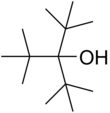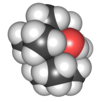2,2,4,4-Tetramethyl-3-t-butyl-pentane-3-ol
2,2,4,4-Tetramethyl-3-t-butyl-pentane-3-ol or tri-tert-butylcarbinol is an organic compound with formula C13H28O, ((H3C)3C)3COH, or tBu3COH.[1] It is an alcohol that can be viewed as a structural analog of a tridecane isomer (2,2,4,4-tetramethyl-3-t-butylpentane) where the central hydrogen has been replaced by a hydroxyl group -OH.
| |||
| Names | |||
|---|---|---|---|
| IUPAC name
3-tert-Butyl-2,2,4,4-tetramethylpentan-3-ol | |||
| Identifiers | |||
3D model (JSmol) |
|||
| ChemSpider | |||
PubChem CID |
|||
CompTox Dashboard (EPA) |
|||
| |||
| |||
| Properties | |||
| C13H28O | |||
| Molar mass | 200.366 g·mol−1 | ||
Except where otherwise noted, data are given for materials in their standard state (at 25 °C [77 °F], 100 kPa). | |||
| Infobox references | |||
Tri-tert-butylcarbinol is arguably the most sterically hindered alcohol that has been prepared to date. In contrast to all other known alcohols, the infrared spectrum of the liquid does not exhibit a broad OH absorption associated with intermolecular hydrogen bonding, making it interesting for research in spectroscopy.[2] The bulky tert-butyl groups (H3C)3C- groups attached to the central carbon prevent the formation of a O–H---O hydrogen bond with another molecule, an intermolecular interaction typical of alcohols.
Another structural analog, in which the COH group is replaced by N, is tri-tert-butylamine, a molecule predicted to be stable but has never been prepared.
References
- Z. Malarski (1974). "Solid rotator phases in 2,2,4,4-tetramethyl-3-tert-butyl-3-pentanol (t-Bu3COH)". Mol. Cryst. Liq. Cryst. 25 (3–4): 259–272. doi:10.1080/15421407408082805.
- Irena Majerza; Ireneusz Natkaniec (2006). "Experimental and theoretical IR, R, and INS spectra of 2,2,4,4-tetramethyl-3-t-butyl-pentane-3-ol". J. Mol. Struct. 788 (1–3): 93–101. doi:10.1016/j.molstruc.2005.11.022.

